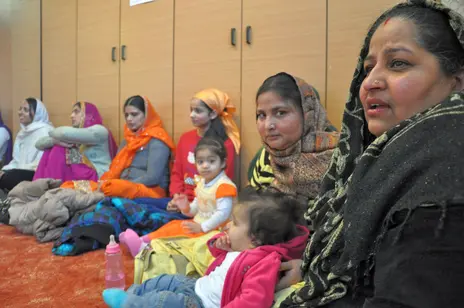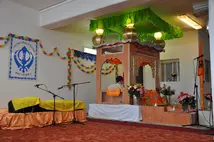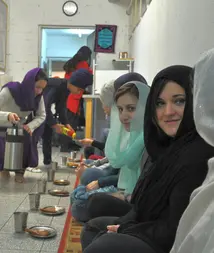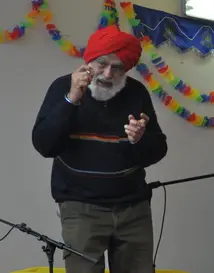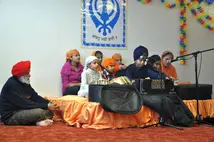Daytrip to the Gurdwara Sagar Gobing (Würzburg)

On January 13, participants of the seminar "Writing India and the Indian Diaspora" visited the Gurdwara Sagar Gobing, the Sikh community centre in Würzburg, to take part in the Sunday ceremony.
The first indication that we are standing in front of the Sikh community centre is a small sign on an otherwise rather unremarkable building, right above a painting of the ‘Khanda’, the symbol of the Sikh faith. The emblem shows a double-edged sword framed by two other swords, symbols for the doctrines of Sikhism. Encouraged by this symbol, we enter the building.
We are a group of nine students who attend the seminar on Indian literature and the Indian Diaspora, and the trip to the Sikh community centre (called ‘Gurdwara’) in Würzburg was organised by our instructor, Susan Brähler, to offer us a real glimpse inside one of the cultures/religions that we discuss in class.
Inside, we are greeted very friendly and politely asked to take off our shoes and socks to put them on a shelf. We wash our hands before we enter the Gurdwara, and cover our hair (most of us have brought scarves, but we could have also taken one of the bright orange cloths out of a large box available to all visitors). We bow in front of the altar and then move to sit down on the fluffy carpet – men on the right side, women on the left.
For a while, we listen to a Sikh reading in Punjabi from the ‘Guru Granth Sahib’ (the holy scripture of the Sikhs, which contains the doctrines of the ten gurus who shaped the Sikh faith) until we are asked to have breakfast. We line up on a mat in the corridor and are served tea with milk and spices, fried vegetables and toast. Children of different ages bring the food, and they take their task very seriously, like only children can. Other women sit down next to us, chatting and telling us about their children.
After we have finished our meal, we return to the prayer room. Little by little, the room fills with people, most of them wearing one of the orange head scarves. The women wear colourful and beautifully embroidered saris and dresses, and the children run back and forth between their mothers and fathers.
When the teacher has finished his reading, one of the elders of the community steps up in front of us, and (just for us guests), explains the principles of the Sikh faith. He tells us about the gurus, about the basic doctrines of their religion and that the word “Sikh” means “student.” He talks about how Sikhism relates to other religions, and is glad to answer our questions.
Next, the children sing songs in Punjabi and play instruments, and the community joins in, clapping along with the children. The singing is followed by more prayers and a joint lunch, but because we have to catch our train, we quietly sneak out of the Gurdwara. When we sit down in the bus headed for the train station, we still have the scent of exotic spices and flavours in our noses.
Lisa Kalkowski
